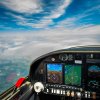Pascal Forget
Pre-takeoff checklist
DA20-C1s enter the yellow arc at 106 knots. With the MT cruise propellers they will pretty easily cruise at 120-130 knots and even slightly faster when equipped with wheel pants. With an old Sensenich wooden propeller, mine does cruise at just below the yellow arc.


